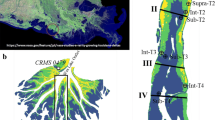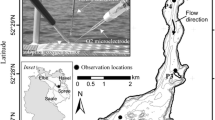Abstract
Movement of water overlying the sediments has not been taken into consideration in most of the experiments conducted to estimate the dissolved material flux from the sediment. Even in recent experiments that incorporated the stirring motion, interpretation of the data is difficult, because the mixing rate used may be different from actual mixing rate in the field. We propose a method to estimate the in situ mixing rate that should be used to set the flow rate in a flow-through core incubation system. The flow rate is calculated from the vertical mixing rate of the water that is deduced from the heat diffusivity. Release rates of NO3+NO2–N obtained from our flow-through incubation system were higher by 1–3 orders of magnitude than those from the conventional diffusion calculation method that estimates the flux from the gradient of nutrient concentration across the sediment-water interface. Increase in NO3+NO2–N flux is considered to be due to intensification of the nitrification process as a result of an increase in dissolved oxygen (DO) supply with the motion of water. DO supply is also considered to be an important factor controlling macrofaunal abundance and consequently their excretory contributions to the fluxes of dissolved organic nitrogen as well as NH4–N. From this point of view, we strongly recommend the application of heat and mass balance theory to estimate nitrogen flux using a flow-through experimental system.
Similar content being viewed by others
References
Andrews, D. & A. Bennett, 1981. Measurements of diffusivity near the sediment-water interface with a fine-scale resistivity probe. Geochim. Cosmochim. Acta 45: 2169–2175.
Azam, F., T. Fenchel, J. G. Field, J. S. Gray, L. A. Mayer-Reil & F. Thingstad, 1983. The ecological role of water-column microbes in the sea. Mar. Ecol. Prog. Ser. 10: 257–263.
Boynton, W. R. & W. M. Kemp, 1984. Nutrient regeneration and oxygen consumption by sediments along an estuarine salinity gradient. Mar. Ecol. Prog. Ser. 23: 45–55.
Boynton, W. R., W. M. Kemp, C. G. Osborne, K. R. Kaumeyer & M. C. Jenkins, 1981. Influence of water circulation rate on in situ measurements of benthic community respiration. Mar. Biol. 65: 185–190.
Callender, E. & D. Hammond, 1982. Nutrient exchange across the sediment-water interface in the Potomac river estuary. Est. coast. Shelf Sci. 15: 395–413.
Cowan, J. L. W., J. R. Pennock & W. R. Boynton, 1996. Seasonal and interannual patterns of sediment-water nutrient and oxygen fluxes in Mobile Bay, Alabama (U.S.A.): regulating factors and ecological significance. Mar. Ecol. Prog. Ser. 141: 229–245.
Henriksen, K., M. B. Rasmussen & A. Jensen, 1983. Effect of bioturbation on microbial nitrogen transformations in the sediment and fluxes of ammonium and nitrate to the overlying water. Ecol. Bull. 35: 193–205.
Hosomi M, M. Okada & R. Sudo, 1984. A comparison of methods for estimating nutrient release from lake sediments. In Proc. U.S.-Japan Meeting on the Management of Bottom Sediment Containing Toxic Substances, U.S. Army Eng. Waterways Exp. Stu. Environ. Lab.: 238-250.
Jørgensen, B. B. & D. J. Des Marais, 1990. Diffusive boundary layer of sediments: oxygen microgradients over a microbial mat. Limnol. Oceanogr. 35: 1343–1355.
Kamiyama, K., S. Okuda & A. Kawai, 1976. Studies on the release of ammonium nitrogen from the bottom sediments in freshwater bodies-I. A preliminary experiment using an annular channel. Jap. J. Limnol. 37: 59–66 (in Japanese with English abstract).
Kamiyama, K., S. Okuda & A. Kawai, 1979. The distribution of ammonium nitrogen in the sediments and its release into overlying water in water regions. Wat. Waste 21: 285–291 (in Japanese).
Larsen, P. D., J. Van Sickle, K. W. Malueg & P. D. Smith, 1979. The effect of waste water phosphorus removal on Shagawa Lake, Minnesota: phosphorus supplies, lake phosphorus and chlorophyll-a. Wat. Res. 13: 1259–1272.
Lerman, A., 1979. Geochemical Processes: Water and Sediment Environments. John Wiley & Sons, New York: 481 pp.
Li, Y. H. & S. Gregory, 1974. Diffusion of ions in sea water and in deep-sea sediments. Geochim. Cosmochim. Acta 38: 703–714.
Maita, Y. & M. Yanada, 1990. Vertical distribution of total dissolved nitrogen and dissolved organic nitrogen in seawater. Geochem. J. 24: 245–254.
Martin, D. C. & D. A. Bella, 1971. Effect of mixing on oxygen uptake rate of estuarine bottom deposits. J. Wat. Pollut. Cont. Fed. 43: 1865–1876.
Nakamura, Y., 1994. Effect of flow velocity on phosphate release from sediment. Wat. Sci. Tech. 30: 263–272.
Nakamura, Y., 1997. Sediment oxygen demand and phosphate release rate: Significance of the processes in the benthic boundary layer. Bull. coast. Oceanogr. 35: 15–25 (in Japanese with English abstract).
Nakamura, Y., T. Inoue, T. Komatsu, T. Yanagimachi, F. Kerciku, M. Yamamuro, H. Kamiya, Y. Ishitobi, M. Sayama & H. Maeda, 1997. Proposal of experimental methods for nutrients release and SOD. Suikogaku Ronbunshu 41: 433–438 (in Japanese with English abstract).
Reay, W. G., D. L. Gallagher & G. M. Simmons Jr., 1995. Sedimentwater column oxygen and nutrient fluxes in nearshore environments of the lower Delmarva Peninsula, U.S.A. Mar. Ecol. Prog. Ser. 118: 215–227.
Sasaki, H., O. Nishimura & R. Sudo, 1995. Effect of resusupension on nutrient release from sediment in shallow estuary. J. Jap. Soc. Wat. Environ. 18: 51–59 (in Japanese with English abstract).
Sasaki, K. & Y. Sawada, 1980. Determination of ammonia in estuary. Bull. Jap. Soc. Fish. 46: 319–321.
Shiozawa, T., K. Kawana, Y. Yamaoka, A. Hoshika, T. Tanimoto & O. Takimura, 1984. Distribution of pollutant in sea water and its dissolution out of bottom sediment in the Seto Inland Sea I. Phosphorus and nitrogen. Rep. gov. ind. Res. Inst. Chugoku 21: 13–43 (in Japanese with English abstract).
Sixth Regional Maritime Safety Headquarter, 1988-1994. Kaiyo Gaiho: 16 pp. (in Japanese) (Survey Report on the Coastal Sea Area of Hiroshima Bay).
Sonzogni, W. C., D. P. Larsen, K. W. Malueg & M. D. Schuldt, 1977. Use of large submerged chambers to measure sedimentwater interactions. Wat. Res. 11: 461–464.
Strickland, J. D. H. & T. R. Parsons, 1972. A practical handbook of sea water analysis. Bull. Fish. Res. Bd Can. 310 pp.
Sundbaeck, K., V. Enoksson, W. Graneli & K. Pettersson, 1991. In-fluence of sublittoral microphytobenthos on the oxygen and nutrient flux between sediment and water: a laboratory continuous-flow study. Mar. Ecol. Prog. Ser. 74: 263–279.
Ukita, M., H. Nakanishi & M. Amaya, 1975a. Teidei yorino N, P youshutsuryo suitei ni okeru shushu no mondaiten ni tsuite (I). Wat. Waste 17: 1277–1290 (in Japanese) (Several problems on the estimations of N and P release from sediments (I)).
Ukita, M., H. Nakanishi & M. Amaya, 1975b. Teidei yorino N, P youshutsuryo suitei ni okeru shushu no mondaiten ni tsuite (II). Wat. Waste 17: 1392–1401 (in Japanese) (Several problems on the estimations of N and P release from sediments (II)).
Yamamoto, T., O.Matsuda, T. Hashimoto, H. Imose & T. Kitamura, 1998. Estimation of benthic flux of dissolved inorganic nitrogen and phosphorus from sediments of the Seto Inland Sea. Umi no Kenkyu 7: 151–158 (in Japanese with English abstract).
Author information
Authors and Affiliations
Rights and permissions
About this article
Cite this article
Yamamoto, T., Ikeda, H., Hara, T. et al. Applying heat and mass balance theory to determine the flow rate for the measurement of benthic material flux in a flow-through system. Hydrobiologia 435, 135–142 (2000). https://doi.org/10.1023/A:1004037527733
Issue Date:
DOI: https://doi.org/10.1023/A:1004037527733




